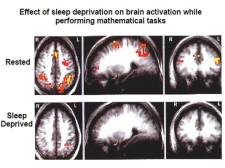III. The Intersection of School Start Time “Policies” and Adolescent Sleep, Health, & Potential
“In sum, early school start times clearly contribute to sleep-deprivation in growing teens, making them even more vulnerable to all the challenges of adolescence, and increases the likelihood of accidents, psychological problems, and impaired learning in school.” (2)—Edward O’Malley, Ph.D., Assistant Professor of Medicine, New York University School of Medicine, Director, Norwalk Hospital Sleep Disorders Center, Mary O’Malley, M.D., Ph.D., Clinical Instructor, Department of Psychiatry, New York University, Fellowship Director, Norwalk Hospital Sleep Disorders Center.
U.S. Start Time Policies vs. Circadian Phase Delay
In the early part of the 20th century, studies showed that children and adolescents in England and Germany, where schools began between 7 a.m. and 8 a.m., slept less than adolescents in the western United States. (250.7) In 1913, recognizing the association between start times and sleep sufficiency, Stanford educational psychologist Lewis M. Terman counseled,
between 7 a.m. and 8 a.m., slept less than adolescents in the western United States. (250.7) In 1913, recognizing the association between start times and sleep sufficiency, Stanford educational psychologist Lewis M. Terman counseled,
“The European custom of beginning school at 7 to 8 o’clock in the morning works great hardship, often causing the pupil to rush away to school in nervous haste and without breakfast. The American practice of beginning at 9 o’clock is far wiser, and should never be changed unless for very special reasons.” (289.5)
Most U.S. schools abandoned this “wiser” practice long ago, although the reasons for doing so may have been less than “special.” Matthew Wolf-Meyer, an Associate Professor of Anthropology at Binghampton University, offers this explanation for the shift to earlier school scheduling:
“[T]he basis of modern school start times lies in the 19th century, when public schools were developed to care for the children of day laborers—meanwhile, the elite would send their children to boarding schools. The school day developed alongside the industrial workday to allow parents to drop off their children while they worked. There’s nothing natural about it—it isn’t based on some agrarian past where we were more in balance with nature. Instead, it had everything to do with the need to fill factories with able-bodied adults from dawn until dusk and to keep their children busy. Only slowly did this change, as American work schedules changed.” (61, citing Wolf-Meyer, The Slumbering Masses: Sleep, Medicine, and Modern American Life (Univ. Minn. Press, 2012) pp. 176, 196-198.)
 As late as the 1950’s and 1960’s, most U.S. schools started between 8:30 a.m. and 9 a.m. (292) Over the past several decades, however, there has been a push to start the school day earlier for secondary school students. (2, 12, 21, 22, 57, 293, 295, Smolensky & Lamberg, The Body Clock: Guide to Better Health (Henry Holt & Co. 2000) p. 87.) In 1998, the National Institutes of Health reported, “Preliminary data indicate a trend over the past 25 years toward earlier school start times, with high schools starting earlier than middle and elementary schools.” (55.4) A comparison of National Center for Education Statistics start time data for 2007-2008 (291) and 2011-2012 (20.5) suggests this trend has not lost its momentum.
As late as the 1950’s and 1960’s, most U.S. schools started between 8:30 a.m. and 9 a.m. (292) Over the past several decades, however, there has been a push to start the school day earlier for secondary school students. (2, 12, 21, 22, 57, 293, 295, Smolensky & Lamberg, The Body Clock: Guide to Better Health (Henry Holt & Co. 2000) p. 87.) In 1998, the National Institutes of Health reported, “Preliminary data indicate a trend over the past 25 years toward earlier school start times, with high schools starting earlier than middle and elementary schools.” (55.4) A comparison of National Center for Education Statistics start time data for 2007-2008 (291) and 2011-2012 (20.5) suggests this trend has not lost its momentum.
Data for 2011-2012 reflect an average start time of 7:59 a.m. for U.S. public junior and senior high schools, (20.5) one minute earlier than for the years 2007-2008. (291) The number of these schools beginning morning classes before 8 a.m. increased by 2.2 percent to 42.5 percent for 2011-2012. (20.5) Junior and senior high schools starting before 7:30 a.m. increased by .7 percent to 9.5 percent from 2007-2008 (291) to 2011-2012. (20.5) The number of junior and senior high schools starting at 8:30 a.m. or later decreased in number from 15.2 percent (291) to 14.4 percent. (20.5) Of these schools, only 3.8 percent started at 9 a.m. or later for the years 2011-2012, (20.5) down .3 percent from 2007-2008. (291)

Schools begin early for administrative and financial reasons, rather than because of any perceived benefits to student welfare. (12, 296) “The starting time of school puts limits on the time available for sleep. This is a nonnegotiable limit established largely without concern for sleep.” (5) Multi-tiered busing schedules often save school districts money. (12, 296) Accommodating athletics also factors significantly into start time determinations. (12, 58)
Most districts schedule classes so that children begin school earlier as they grow older. (12) “Ironically, the school starting time moves earlier as children’s grade advances. Although school starts earlier, children cannot adjust their bedtime accordingly, and this could result in sleep deprivation. Subsequently, they are sleepy in the morning and become more alert in the afternoon when school is almost over.” (Cardinali, Chronoeducation: How the Biological Clock Influences the Learning Process, publish. in, The Educated Brain: Essays in Neuroeducation (Battro, Fischer, & Léna, edit., Cambridge Univ. Press 2008) p. 121, citation omitted.) “This change to the circadian rhythm is in contrast to the extrinsic demands of an early school start time, resulting in an overall decrease in total sleep duration. In essence, adolescents must be awake and learning at a time of day when their bodies should be sleeping.” (298)
In 1993, Brown University scientists cautioned, “[T]he widespread practice in U.S. school districts for school buses to run and for the opening bell to ring earlier at high schools than at junior high schools, and earlier in junior high schools than primary schools, may run precisely counter to children’s biological needs.” (1) In 1997, the National Institutes of Health began echoing this concern, pointing to early school start times as a factor contributing to restricted sleep and its attendant risks among adolescents. (55, 55.2, 55.4)

“Recent data indicate that regulation of the circadian timing system may change during pubertal development and contribute to delayed timing. This type of sleep phase delay is in direct conflict with early school starting times, which form an uncontrollable and nonnegotiable aspect of a child’s daily program. Youngsters faced with a lengthy commute to school have an even more difficult schedule problem. Oversleeping during the school week is not a legitimate option for adolescents, and early bedtimes may not be achievable for adolescents at the dawning of the 21st century due to biological and psychosocial impediments. [¶] Significant among the adverse outcomes are studies showing that problem sleepiness can lead to degraded school performance, emotional stress, alcohol and drug abuse, and a disturbingly high rate of fatal motor vehicle crashes in older adolescent and young adult males.” (55)
Around the turn of the nineteenth century, the size of the rural school district was governed by the distance a child could reasonably  be expected to walk. (299) Now children may be required to ride buses for an hour or more to attend school. (300) “[T]eenagers faced with long school bus rides in addition to early starting time for school may confront incremental challenges in conflict with the biological propensities.” (1) Many bus riders rise during the 5 o’clock hour (or earlier) to meet the morning bell. (3, 301) In Maryland, Anne Arundel County Public Schools buses begin collecting high school students as early as 5:30 a.m. for 7:17 a.m. classes. (299.5) Students are required to arrive 10 minutes before pickup, a full two hours before sunrise in the winter months. (299.5, see also, ns. 300, 302, 303.)
be expected to walk. (299) Now children may be required to ride buses for an hour or more to attend school. (300) “[T]eenagers faced with long school bus rides in addition to early starting time for school may confront incremental challenges in conflict with the biological propensities.” (1) Many bus riders rise during the 5 o’clock hour (or earlier) to meet the morning bell. (3, 301) In Maryland, Anne Arundel County Public Schools buses begin collecting high school students as early as 5:30 a.m. for 7:17 a.m. classes. (299.5) Students are required to arrive 10 minutes before pickup, a full two hours before sunrise in the winter months. (299.5, see also, ns. 300, 302, 303.)
Among adults, researchers have found that commuting substantial distances to work makes capturing adequate sleep unlikely. (304, 304.1, 304.2, 304.3) Individuals residing more than a 25-minute drive from the workplace get significantly less sleep than individuals residing closer to the office. (304.2, 304.3) Long commutes via automobile, bus, and train have been associated with a range of adverse psychological and health effects, including increased stress and its attendant consequences (e.g., cardiovascular disease and suppressed immune functioning), exposure to dust, noise, volatile hydrocarbons, smoke, and infection. (304.4, 304.5, 304.6, 304.7, 304.8, 304.9, 305) A 2005 University of Kent study found bus riders more likely to be depressed than individuals travelling by train or car. (305) Sedentary behavior or physical inactivity, generally a feature of motorized transport, has been associated with type II diabetes, cardiovascular events, disease, and increased risk for obesity. (305.1, 305.2, 305.3)
While scientists encourage active travel (e.g., walking, cycling), among minors, the mode of transportation utilized appears to be “more related to social and environmental factors than to the students’ freedom of choice.” (305.5) A recent study of Brazilian adolescents comparing students actively commuting with students traveling via motorized transport found that irrespective of the mode of travel, the longer the commute, the less sleep students obtained. (305.5, cf. n. 305.6.)
Early Starting Schools vs. Sleep, Welfare, & Cognition
As previously noted (see, § I, supra), high school students lose up to two hours or more of sleep on school nights as compared to weekends or weekdays during summer. (6, 28, 107, 107.5, Mindell & Owens, Clinical Guide to Pediatric Sleep: Diagnosis and Management of Sleep Problems (Lippincott Williams & Wilkins, 2nd ed. 2010) p. 258.) The 2011 National Sleep Foundation poll found 54% of teenagers (13-18 years) awaken between 5 a.m. and 6:30 a.m. on weekdays, with the majority (81%) getting to bed at 10 p.m. or later. (25) Thus, on school days, 6 in 10 obtain fewer than 8 hours of sleep. (25)
 “Most teenage students would sleep longer on school days if not for the typical 7:30 a.m. or earlier school start-times.” (Rauch, What is Normal Sleep for Children and Adolescents? publish. in, Attention Deficit Disorder: Practical Coping Mechanisms (Fisher, edit., Informa Healthcare, 2nd ed. 2007) p. 175, ns. omitted; see n. 306 [homeschooled students awaken 18 minutes after public and private school students begin morning classes, obtaining 90 minutes more sleep per night].) “The conflict between adolescents’ inherent circadian phase delay and rigid school start times results in chronic sleep deprivation.” (107.5) “Additional weekend sleep does not alleviate this negative effect.” (Wahlstrom, Accommodating the Sleep Patterns of Adolescents Within Current Educational Structures: An Uncharted Path, publish. in, Adolescent Sleep Patterns, Biological, Social, and Psychological Influences (Carskadon, edit., Cambridge Univ. Press 2002) p. 174, ns. omitted.) Weekend oversleep further contributes to circadian disruption and decreased daytime alertness levels. (6) “These kids are essentially in a permanent state of jet lag[.]” (289)
“Most teenage students would sleep longer on school days if not for the typical 7:30 a.m. or earlier school start-times.” (Rauch, What is Normal Sleep for Children and Adolescents? publish. in, Attention Deficit Disorder: Practical Coping Mechanisms (Fisher, edit., Informa Healthcare, 2nd ed. 2007) p. 175, ns. omitted; see n. 306 [homeschooled students awaken 18 minutes after public and private school students begin morning classes, obtaining 90 minutes more sleep per night].) “The conflict between adolescents’ inherent circadian phase delay and rigid school start times results in chronic sleep deprivation.” (107.5) “Additional weekend sleep does not alleviate this negative effect.” (Wahlstrom, Accommodating the Sleep Patterns of Adolescents Within Current Educational Structures: An Uncharted Path, publish. in, Adolescent Sleep Patterns, Biological, Social, and Psychological Influences (Carskadon, edit., Cambridge Univ. Press 2002) p. 174, ns. omitted.) Weekend oversleep further contributes to circadian disruption and decreased daytime alertness levels. (6) “These kids are essentially in a permanent state of jet lag[.]” (289)
Multiple surveys of high school students conducted in the 1980’s and 1990’s found that students who start school at 7:30 a.m. or earlier obtain less total sleep on school nights than students at later starting schools. (21) A study published in 1992 found 12th graders beginning school at 7:40 a.m. reported getting less school-night sleep, more sleep problems, and sleeping later on weekends than 12th graders starting school at 8:30 a.m. (34) (Subjective measures of sleep from children and adolescents are correlated with objective measures.) (307, 308) In 1994, a study of 3,120 adolescents attending four Rhode Island high schools with start times ranging from 7:10 a.m.–7:30 a.m. found most students were sleep deficient. (35, 36) Eighty-seven percent of the students reported needing more sleep than they were getting. (35, 36)
 A 1998 study evaluated the impact of a 65-minute start time advance for forty students transitioning from junior high (9th grade, 8:25 a.m. start time) to high school (10th grade, 7:20 a.m. start time). (38) Objectively documented sleep records demonstrated that only 62% of the students in 9th grade, and fewer than 50% of the students in 10th grade, obtained an average of seven hours or more of sleep on school nights. (38) Students woke significantly earlier on school days in 10th grade than in 9th grade. (38) In 10th grade, students also displayed atypical sleep patterns on a laboratory nap test of sleepiness (Multiple Sleep Latency Test, MSLT). (38) As a group, the 10th grade students “bordered on pathologically sleepy” by 8:30 a.m. (38)
A 1998 study evaluated the impact of a 65-minute start time advance for forty students transitioning from junior high (9th grade, 8:25 a.m. start time) to high school (10th grade, 7:20 a.m. start time). (38) Objectively documented sleep records demonstrated that only 62% of the students in 9th grade, and fewer than 50% of the students in 10th grade, obtained an average of seven hours or more of sleep on school nights. (38) Students woke significantly earlier on school days in 10th grade than in 9th grade. (38) In 10th grade, students also displayed atypical sleep patterns on a laboratory nap test of sleepiness (Multiple Sleep Latency Test, MSLT). (38) As a group, the 10th grade students “bordered on pathologically sleepy” by 8:30 a.m. (38)
“As discussed in the original study, this unusual pattern is disturbing because it mimics the clinical findings of patients with narcolepsy—a major sleep disorder. These findings have been attributed to a combination of too little sleep occurring at a time mismatched to circadian rhythms. In other words, these 10th graders were expected to function in school at a time when their bodies were meant to sleep.” (Wolfson & Richards, Young Adolescents: Struggles with Insufficient Sleep, publish. in, Sleep and Development (Oxford Univ. Press, El Sheikh edit. 2011) p. 269, citations omitted.)
 Recently published studies confirm an inverse relationship between adolescent sleep duration and the time the opening school bell rings; i.e., the earlier the bell, the less sleep students obtain. (2, 28, 30, 37, 39, 107, 309, 314)
Recently published studies confirm an inverse relationship between adolescent sleep duration and the time the opening school bell rings; i.e., the earlier the bell, the less sleep students obtain. (2, 28, 30, 37, 39, 107, 309, 314)
“Thus, early school start time—the main predictor of an earlier wake time among adolescents on school days— conflicts with adolescent circadian biology. The fact that these adolescents spent 2 hours less time in bed on school days is consistent with the findings of another study of 60 high school seniors that found an average 2-hour reduction in sleep on school days. Another study found that students attending schools with later start times (8:37 a.m. vs 7:15 a.m.) obtained almost 1 hour more sleep. [O]ur findings confirm that on school days, adolescents are obtaining less sleep then they are considered to need, and school start time is the factor with the greatest impact. If sleep loss is associated with impaired learning and health, then these data point to computer use, social activities and especially school start times as the most obvious intervention points.” (28)
A 2011 study of 1,941 9th-12th grade New Jersey high school students with start times ranging from 7 a.m. to 8:45 a.m. found earlier school starting times associated with shorter weekday sleep duration, naps after school, and night awakenings. (145) Reduced sleep quantity and/or quality were associated with poor school performance. (145) “It is now widely accepted that sleep deprivation is associated with reduced alertness and poor performance, and these effects are exacerbated by a superimposed circadian disadvantage.” (145)
A 2014 University of Minnesota survey of 9,089 high school students with start times ranging from 7:30 a.m. to 8:55 a.m. found student sleep increased the later school day began. (309) On average, 33.6% of students starting classes at 7:30 a.m. obtained eight or more hours on school nights. (309) Less than half of all students starting classes before 8:35 a.m. managed to obtain eight or more hours of sleep on school nights. (309) Just over 66% of students starting at 8:55 a.m. captured eight or more hours of sleep. (309)
“[G]iven the analyses summarized here, there are clear benefits for students whose high schools start at 8:30 AM or later. This would include, for teens who reported they got at least 8 hours of sleep per night, that they were more likely to say they have good overall health and were less likely to report being depressed or using caffeine and other substances (e.g., alcohol, tobacco, other drugs). Other positive findings include a significant reduction in local car crashes, less absenteeism, less tardiness, as well as higher test scores on national achievement tests.” (309)
The National Institutes of Health has identified adolescents and emerging adults (ages 12-25) as populations at “high risk” for problem sleepinesss. (55, 265) While less likely than their older peers to draw an early start time, middle school students may also be compelled to attend early starting schools.  “[I]ncreasing societal demands promoted by a 24/7 culture over the past three decades have contributed to even earlier school start times for both middle and high school students.” (2) Consistent with biological evidence establishing the arrival of adolescent changes in sleep (delayed sleep phase and disrupted sleep) with, (1, 2, 103) or even before the onset of puberty, (250.5) studies of middle school students have found early school schedules associated with sleep deficiency and its associated difficulties. (22, 23, 30, see, Appendix F, infra, Middle School Studies, etc.)
“[I]ncreasing societal demands promoted by a 24/7 culture over the past three decades have contributed to even earlier school start times for both middle and high school students.” (2) Consistent with biological evidence establishing the arrival of adolescent changes in sleep (delayed sleep phase and disrupted sleep) with, (1, 2, 103) or even before the onset of puberty, (250.5) studies of middle school students have found early school schedules associated with sleep deficiency and its associated difficulties. (22, 23, 30, see, Appendix F, infra, Middle School Studies, etc.)
In 2004, researchers studying a cohort of 2,259 students, aged 11 to 14 years, found that students who obtained less sleep in sixth grade exhibited lower initial self-esteem and grades and higher initial levels of depressive symptoms. (23) Similarly, students who obtained less sleep over time reported heightened levels of depressive symptoms and decreased self-esteem. (23) A 2007 study of New England middle school children found that “[i]n addition to the sleep deficit, school records indicated that students at the earlier starting school [7:15 a.m.] were tardy four times more frequently, and eighth graders at the earlier starting school obtained significantly worse average grades than the eighth graders at the comparison, later starting school [8:37 a.m.].” (30) “The often serious impact of this chronic under-sleeping is now evident in both high school and middle school students.” (2)
“[E]arlier start times are associated with significant sleep deprivation, daytime fatigue, irregular sleep schedules, and the tendency to fall asleep at school… [¶] This clash between bodily rhythms and contextual factors can have a wide variety of negative consequences. … Insufficient sleep results in an increased risk for school absences because of physical illness, falling asleep in school, oversleeping in the morning, fatigue, and irritability, all of which are detrimental to academic outcomes[.]” (23)
 Students attending early starting schools may carry “significant chronic sleep debt.” (38) “Failure to adjust education timetables to this biological change leads to systematic, chronic and unrecoverable sleep loss. This level of sleep loss causes impairment to physiological, metabolic and psychological health in adolescents while they are undergoing other major physical and neurological changes[.]” (65)
Students attending early starting schools may carry “significant chronic sleep debt.” (38) “Failure to adjust education timetables to this biological change leads to systematic, chronic and unrecoverable sleep loss. This level of sleep loss causes impairment to physiological, metabolic and psychological health in adolescents while they are undergoing other major physical and neurological changes[.]” (65)
Children “may feel adapted to being tired, but performance tests show the opposite.” (310, 311) Sleep researchers have found that as individuals are increasingly sleep deprived, they also become increasingly unaware of how sleep deprived they really are. (312) “[P]eople who are sleep-deprived are less efficient, thus a cycle develops in which a student takes longer to complete the same amount of work, leading to her staying up later, and starting the vicious cycle all over again.” (Mindell & Owens, Clinical Guide to Pediatric Sleep: Diagnosis and Management of Sleep Problems, supra, p. 258.) Although conventional wisdom holds that individuals can ‘train’ themselves to adapt to less sleep, “laboratory tests belie this.” (313) Harvard’s Steven Lockley points out, “There’s no training people to live without sleep[.] It’s like trying to train people to live without food.” (313.5)
Researchers have found a “general ‘cloud’ of negative daily affect that is associated with chronic patterns of inadequate sleep among adolescents….” (118) “Chronically sleep-deprived teens often become so used to the feeling of sleepiness that they don’t recognize that they are settling for less than they are capable of in creativity, academic performance, and communication both in and out of the classroom.” (Rauch, What is Normal Sleep for Children and Adolescents? publish. in, Attention Deficit Disorder: Practical Coping Mechanisms, supra, p. 175.) Early rise times also interrupt a critical sleep phase.
“Getting adequate dream (rapid eye movement [REM]) sleep is essential to perceptual, cognitive, and emotional processing. Selective REM sleep deprivation has been demonstrated to cause symptoms of irritability and moodiness, as well as problems with memory. The issue of under-sleeping in adolescents takes on added significance when one considers that waking up too early costs the sleeper mostly REM sleep which predominates during the last two to three hours of a night’s sleep.” (2)
 In REM sleep, many parts of the brain are as active as at any time when awake. (191) One study found that REM sleep affects learning of certain mental skills. People taught a skill and then deprived of non-REM sleep could recall what they had learned after sleeping, while people deprived of REM sleep could not. (192) While still teaching at Cornell, now retired Professor of Psychology James Maas would have sleep-deprived students wear sleep-monitoring headbands and then show them magnetic resonance images of their brains. “You can see that nothing is going on in their brains. Literally nothing.” (314.5) Professor Avi Sadeh, Sc.D., a leading authority in this field, has concluded that in teens, “A loss of one hour of sleep is equivalent to [the loss of] two years of cognitive maturation and development.” (62, 142)
In REM sleep, many parts of the brain are as active as at any time when awake. (191) One study found that REM sleep affects learning of certain mental skills. People taught a skill and then deprived of non-REM sleep could recall what they had learned after sleeping, while people deprived of REM sleep could not. (192) While still teaching at Cornell, now retired Professor of Psychology James Maas would have sleep-deprived students wear sleep-monitoring headbands and then show them magnetic resonance images of their brains. “You can see that nothing is going on in their brains. Literally nothing.” (314.5) Professor Avi Sadeh, Sc.D., a leading authority in this field, has concluded that in teens, “A loss of one hour of sleep is equivalent to [the loss of] two years of cognitive maturation and development.” (62, 142)
A recent study of Chicago public high schools found that students beginning classes at 8 a.m. showed marked deficiencies in first period courses throughout the term. (318) As in other early starting schools, (2, 30, 41) the students were more likely to be absent in first period relative to other periods. (318, see discussion, n. 578, infra.) Harvard Professor of Sleep Medicine Susan Redline, M.D., M.P.H., notes that 8 a.m. classes begin too early for adolescent students to obtain sufficient sleep and serve to interrupt REM sleep. (319)
Advancing School Start Times; i.e., Inviting Injury
 While some districts have implemented later school scheduling, (31, 37, 41, see, Appendix A, infra, Schools Recently Delaying Start Times, etc.), most retain earlier or (relatively) later scheduling over time. (12) Still others advance secondary school start times to increase instructional hours, or more often, to address budgetary, busing, or athletic concerns (see, e.g., Appendix B, infra, Schools Recently Advancing Start Times, etc.), despite longstanding evidence that “[t]his advance of the school day is in direct conflict with a putative pubertal/adolescent phase delay.” (38) In 2002, Stanford Professor emeritus of Sociology Sanford Dornbusch surmised that adult nescience could explain early secondary school scheduling. (59) “Adults, unaware of the sleep needs of adolescents, require them to start school earlier in the day than is required of younger children.” (59)
While some districts have implemented later school scheduling, (31, 37, 41, see, Appendix A, infra, Schools Recently Delaying Start Times, etc.), most retain earlier or (relatively) later scheduling over time. (12) Still others advance secondary school start times to increase instructional hours, or more often, to address budgetary, busing, or athletic concerns (see, e.g., Appendix B, infra, Schools Recently Advancing Start Times, etc.), despite longstanding evidence that “[t]his advance of the school day is in direct conflict with a putative pubertal/adolescent phase delay.” (38) In 2002, Stanford Professor emeritus of Sociology Sanford Dornbusch surmised that adult nescience could explain early secondary school scheduling. (59) “Adults, unaware of the sleep needs of adolescents, require them to start school earlier in the day than is required of younger children.” (59)
More than a decade later, “a burgeoning literature” demonstrating the ill effects of early school scheduling (315) should compel reconsideration of Professor Dornbusch’s theory. As the examples below and elsewhere illustrate (see, e.g., Appendix G, infra, Incognizant “Educators”), few school leaders demonstrate awareness of, or interest in, the pertinent evidence, despite science-based objections by fellow educators, (317) sleep experts, (316) students, (316) and/or parents, (320) often preceding such a change. (See, e.g., Appendix B, infra, Schools Recently Advancing Start Times, etc. [Orchard Park Secondary School, Canada; Cherry Hill Public Schools, N.J.].)
In May of 2012, when Pittsburgh Public Schools proposed advancing 2012-2013 high school start times by 30 minutes to 7:36 a.m., or by 60 minutes to 7:06 a.m., in order to save $1.2 million in transportation costs, Wendy Troxel, a RAND Corporation behavioral and social scientist, and Adjunct Assistant Professor of Psychiatry at the University of Pittsburgh School of Medicine, joined by more than 50 colleagues, warned against implementing such a plan. (317)
“Robust evidence has long demonstrated the adverse consequences of early school start times for teenagers’ academic, mental, social and physical well-being. And no, they can’t just go to bed earlier — their hormones won’t let them. [¶] Keeping the ultimate goal of our education system in mind (to prepare students to become contributing members of society), evidence suggests that earlier school start times are associated with significant reductions in academic achievement — with the strongest effects among the most economically disadvantaged students. [¶] We understand there is no easy fix for the Pittsburgh public schools’ budget problems. But making a short-sighted decision that flies in the face of unequivocal scientific evidence would, in the long term, cost the city of Pittsburgh far more in terms of lost wages, higher rates of crime, more motor vehicle accidents and increased rates of obesity and associated health complications. [¶] Before deciding to move up start times — whether by an hour or a half hour — the Pittsburgh school board should weigh against a negligible savings in dollars the considerable costs to our children and to our society. [¶] As scientists, parents and members of the Pittsburgh community, we strongly oppose making school start times earlier, even by a half hour.” (317)
[¶] We understand there is no easy fix for the Pittsburgh public schools’ budget problems. But making a short-sighted decision that flies in the face of unequivocal scientific evidence would, in the long term, cost the city of Pittsburgh far more in terms of lost wages, higher rates of crime, more motor vehicle accidents and increased rates of obesity and associated health complications. [¶] Before deciding to move up start times — whether by an hour or a half hour — the Pittsburgh school board should weigh against a negligible savings in dollars the considerable costs to our children and to our society. [¶] As scientists, parents and members of the Pittsburgh community, we strongly oppose making school start times earlier, even by a half hour.” (317)
As in many jurisdictions, short-term fiscal gains prevailed over student well-being and potential. The 2012-2013 bell schedule posted at the Pittsburgh Public Schools website reflects a 7:11 a.m. start time for Pittsburgh Perry High School, 7:34 a.m. at Pittsburgh CAPA 6-12, and 7:36 a.m. for all other high schools and 6-12 schools, suggesting school leadership may favor short-term fiscal gains over student well-being and achievement. This result appears consistent with outcomes found in other jurisdictions. (316, 317, 320)
As discussed infra (see, § IV), any savings realized by advancing morning classes may be undone by the corresponding diminished academic performance; (24, 44, 49) i.e., lower achievement means lower wages (49) and slower growth in the economy. (323, 324, 325) In most U.S. jurisdictions, the time of day school begins is guided not by reference to pertinent literature or consideration of student well-being, but rather by management of budgets, buses, and athletics. (12) In considering the larger picture, Judith Owens, Director of the Center for Pediatric Sleep Disorders, observes:
“There’s no question that later start times pose significant challenges and barriers, … but this is something within our control, something we can change to make a significant impact on the long-term health of children. … If you knew that in your child’s school there was a toxic substance that reduced the capacity to learn, increased the chances of a car crash and made it likely that 20 years from now he would be obese and suffer from hypertension, you’d do everything possible to get rid of that substance and not worry about cost. Early start times are toxic.” (15.5)
As it turns out, economists report that widespread implementation of later school scheduling would pay for itself and then some, contributing billions of dollars to the U.S. economy. (50)


